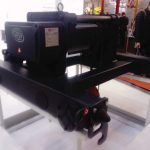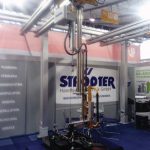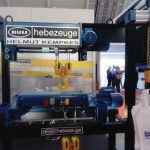Daniel Searle attended the recent Logimat show in Stuttgart, Germany, to speak with exhibitors about their latest products, and their views on the prospects for the market in 2019.
If reports on the German economy are accurate, the usually-reliable industrial giant hit a relatively slow patch in late 2018, only just avoiding falling into recession. One reason for the decline in growth, according to analysis in The Week, is the German market’s reliance on exports—exports accounted for 47% of the economy in 2017, says the report—and so when external markets were hit by issues such as the slowdown in the Chinese economy and the steel tariffs implemented by President Trump, the German economy suffered as a result.
Nevertheless, the impression from the recent Logimat show in Stuttgart was one of a bustling industry, in the overhead lifting sector at least. The show, this year in its 17th iteration, filled one of its halls with companies from this sector, with some other exhibitors from our industry in other halls further along the Stuttgart Messe.
For Schmalz, a vacuum lifting system specialist and manufacturer of accompanying manipulators, jib cranes and light aluminium cranes, the versatility of their products has kept prospects bright. “Schmalz has a very wide product portfolio for many different industry sectors and requirements. So we aren´t depending on one special industry,”
says Michael Schlaich, head of business development process for handling systems at the company. “Growing markets, for example, are the distribution logistics for online shops where the handling of small packages in high frequency is needed. Established industries like the automotive sector or the wood industry still offer great potential for Schmalz.”
For Spanish crane manufacturer Jaso, the show was one method of promoting its products to help boost sales in Germany and the surrounding central European markets. “In the EU, since last year we have experienced a recovery of activity and as economic and industrial activities have grown, the lifting industry has reacted in the same way,” says Raúl Fernández, sales and marketing director at Jaso Industrial Cranes.
“Volumes are far away from the past years before the economic crisis but we, fortunately, have balanced them with our growth in export markets.
“Opportunities include investments in renewable energy sectors like wind and offshore, and the slight recovery in the building industry in general. One of the big challenges is the uncertain situation within the automotive industry due to the diesel regulations that is directly affecting many car manufactures in Europe. Additionally, the political situation due to Brexit and reorganization of political trends in EU will be something to pay attention as they could directly affect the economy.”
Meeting demand for new trends by developing new technology such as the company’s Smartlink system has helped business at Jaso, adds Fernández:
“From our perspective connectivity between cranes and other equipment within the production process is more in demand at this time. In our case, we have developed our own monitoring system for cranes, called Smartlink, that allows you in a very easy and friendly way to control your cranes and to optimize their performance and productivity through the information provided by the system.
“Additionally, and mainly during the last two to three years, everything regarding automation and the development of automatic cranes for different purposes, has been getting increasingly in demand. In that field we have developed different solutions for waste-to-energy cranes, stacker cranes for logistics, and cranes for chemical treatments for the piping industry, that allows our customers to increase the productivity and quality of the products and of course the safety, to minimise the risks for their workers.”
Schmalz also emphasises the demand for safety in its product development— not just in avoiding the risk of accidents but also in ensuring long-term health through ergonomic systems—and for connectivity. Versatility of products is also key, says Schlaich: “There are many customers just searching for an efficient handling solution which optimises their production process. In addition, many customers are searching for lifting aids to prevent musculoskeletal problems of the employees that are frequently caused by the physical strain encountered during operational production and warehouse processes. So, Schmalz offers standard solutions as well as new products which are ready for Industry 4.0.
“Collaboration is becoming an increasingly important topic in manual handling applications. To that end, Schmalz developed the smart rope balancer SRBC. In the spirit of industry 4.0, the rope balancer makes manual lifting tasks smart and digital. The collaborative handling system is suitable for tasks requiring both dynamic movement and precise depositing, for example in joining or assembly processes. Loads of up to 80kg can be moved safely and with little effort—and without the risk of the load overshooting.
“To avoid collisions with fixed obstacles, software can be used to define working spaces, pick-up and deposit points, and travel speeds. The intelligent vacuum lifter evaluates process data and offers a diagnostic function to assist the user. Safety queries prevent collisions as well as lifting and dropping errors and increase work safety.
“We have been producing intelligent manual handling solutions for customers on request. That means for example solutions that offer information about the workpiece, the weight, predictive maintenance and so on.”
Jaso also designed its V range of wire rope hoists to be one of the safest available, says Fernández, with the hoist’s frequency inverter operating in a closed loop to ensure reliability of the transfer of information. The range comprises three models up to 15t capacity, and are suitable for very tough working conditions such as the iron and steel industry.
Daniel Searle attended the recent Logimat show in Stuttgart, Germany



没有评论:
发表评论